There are 5 methods available by which costs can be transferred from a Works Order to an Inventory Item.
| Fset #89 | Works Order Costing method used |
|---|---|
| 0 | Actual Material costs, as applied by a Material Issue, PLUS Estimated Labour and Estimate Machine Cost at the Standard Labour Rate. Variation to COS accounts against Estimates. |
| 1 | Actual Material costs, as applied by a Material Issue, PLUS Estimated Labour and Estimate Machine Cost at the Standard Labour Rate. No Variations written. |
| 2 | Actual Material costs, as applied by a Material Issue, PLUS Estimated Labour and Estimate Machine Cost at the Standard Labour Rate. Variation to COS accounts against Actual Labour / Machine Costs. |
| 3 | Actual Costs, that is actual Material costs Plus Actual Labour and Actual Machine Costs |
| 4 | Reserved. |
The method used is selected via Fset #89 (1 - Set 5),
Admin ,
Configuration,
Feature Settings,
1 - Set 5,

Our sample Works Order (55559) has the following in Tab2 - Values, the MI has been done.

When we stock this Works Order, a series of dialog boxes appear indicating the values being used, simply step through them.,
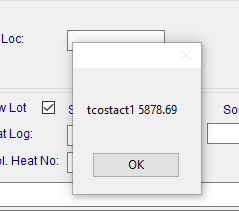
The Actual cost is made up of:-
| Material | 2786.59 |
| Labour | 1092.10 |
| Machines | 2000.00 |
| TOTAL | 5878.69 |
Stepping through the Dialog Boxes we end up with:-
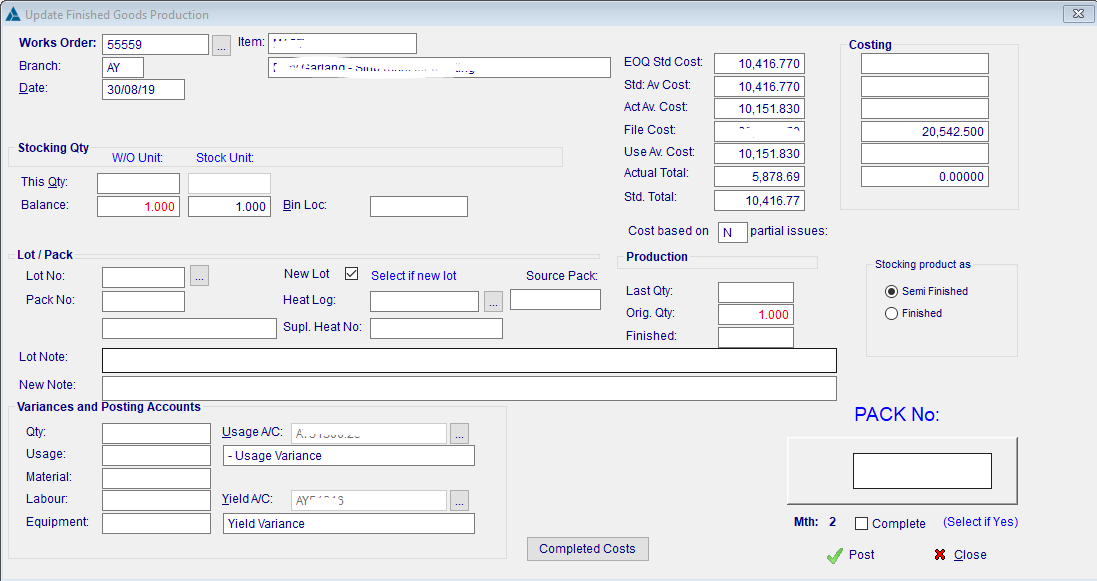
We now Stock this Item
Now look at this Item in inventory, and check the transaction.

In the GL - AC1320 - Inventory Control Acct

In the GL - AC1330 WIP Control Accoount

The Item has been transferred from WIP to Inventory at the Estimated Avg. Cost. That is Actual Material, Estimated Labour and Estimated Machine. The Actual Labour and Machine Costs have been ignored.
2 offsets have also been written, the first ($4865.24) being the Labour Estimate as gone to Labour Cost Recovery, the 2nd ($2500.00) being the Machine Estimate, has gone to Yield Variance.
Together, with the original Material Issue $2786.69, they offset the WIP account, keeping it in balance.
| Transferred from WIP (AC1330) | ($10151.83) |
| Transferred into WIP | |
| $2786.59 |
| $4865.24 |
| $2500.00 |
| Total 'Recovery' | $10151.83 |
| Imbalance | $0.00 |
|---|
Our sample Works Order (55559) has the following in Tab2 - Values, the MI has been done.

When we stock this Works Order, a series of dialog boxes appear indicating the values being used, simply step through them.,

The Actual cost is made up of:-
| Material | 2786.59 |
| Labour | 1092.10 |
| Machines | 2000.00 |
| TOTAL | 5878.69 |
Stepping through the Dialog Boxes we end up with:-
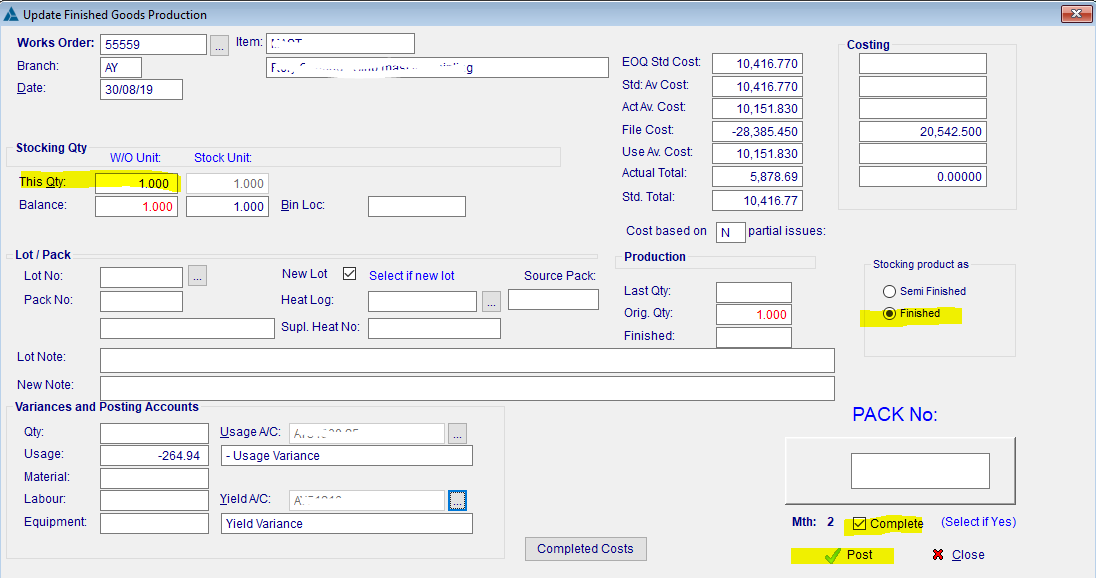
We now Stock this Item
Now look at this Item in inventory, and check the transaction.

In the GL - AC1320 - Inventory Control Acct

In the GL - AC1330 WIP Control Accoount

The Item has been transferred from WIP to Inventory at the Estimated Avg. Cost. That is Actual Material, Estimated Labour and Estimated Machine. The Actual Labour and Machine Costs have been ignored.
No offsets have also been written, which means that we have transferred from WIP (AC1330) MORE than we placed in there. We will have an imbalance between the WIP ledger and the GL control Account.
| Transferred from WIP | ($10151.83) |
| Transferred into WIP | |
| $2786.59 |
| |
| Imbalance | $7365.24 |
|---|
This imbalance (between the actual WIP and the WIP control acoount) will need to be cleared regularly to a Cost of Sale account.
Our sample Works Order (55559) has the following in Tab2 - Values, the MI has been done.

When we stock this Works Order, a series of dialog boxes appear indicating the values being used, simply step through them.,

The Actual cost is made up of:-
| Material | 2786.59 |
| Labour | 1092.10 |
| Machines | 2000.00 |
| TOTAL | 5878.69 |
Stepping through the Dialog Boxes we end up with:-
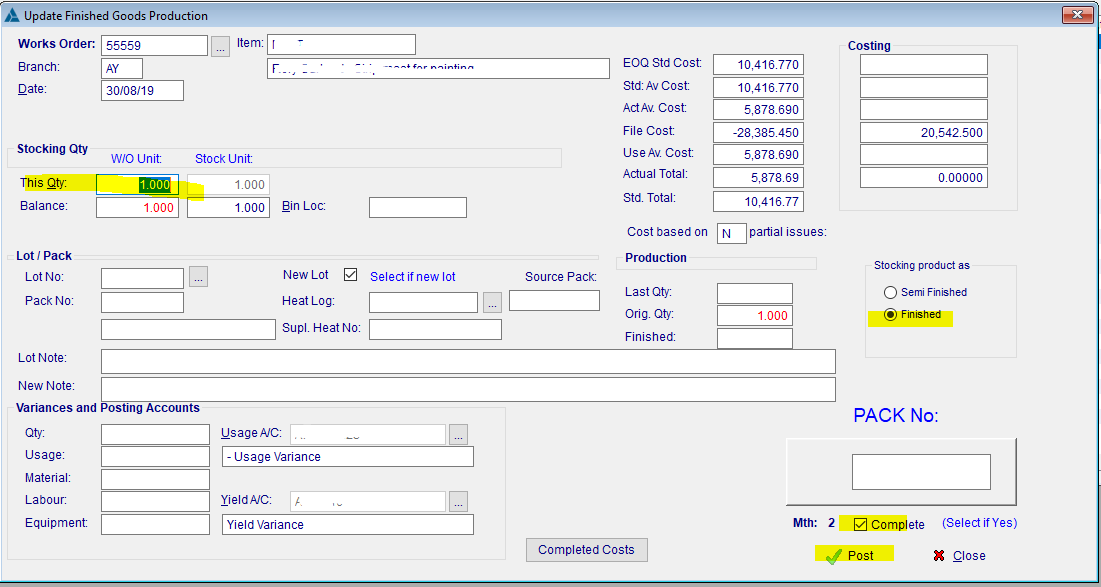
We now Stock this Item
Now look at this Item in inventory, and check the transaction.

In the GL - AC1320 - Inventory Control Acct

In the GL - AC1330 WIP Control Accoount

The Item has been transferred from WIP to Inventory at the Estimated Avg. Cost. That is Actual Material, Estimated Labour and Estimated Machine. The Actual Labour and Machine Costs have been ignored.
2 offsets have also been written, the first ($3773.14) being the Labour Estimate LESS the ACTUAL labour has gone to Labour Cost Recovery,
the 2nd offset ($2500.00) being the Machine Estimate LESS the ACTUAL labour, has gone to Yield Variance.
Together, with the original Material Issue $2786.69, the original Labour and the original Machine Costs, they offset the WIP account, keeping it in balance.
| Transferred from WIP | ($10151.83) |
| Transferred into WIP | |
| $2786.59 |
| $1092.10 |
| $2000.00 |
| $3773.14 |
| $500.00 |
| Total transferred into WIP | $10151.83 |
| Imbalance | $0.00 |
|---|
Our sample Works Order (55559) has the following in Tab2 - Values, the MI has been done.

When we stock this Works Order, a series of dialog boxes appear indicating the values being used, simply step through them.,

The Actual cost is made up of:-
| Material | 2786.59 |
| Labour | 1092.10 |
| Machines | 2000.00 |
| TOTAL | 5878.69 |
Stepping through the Dialog Boxes we end up with:-
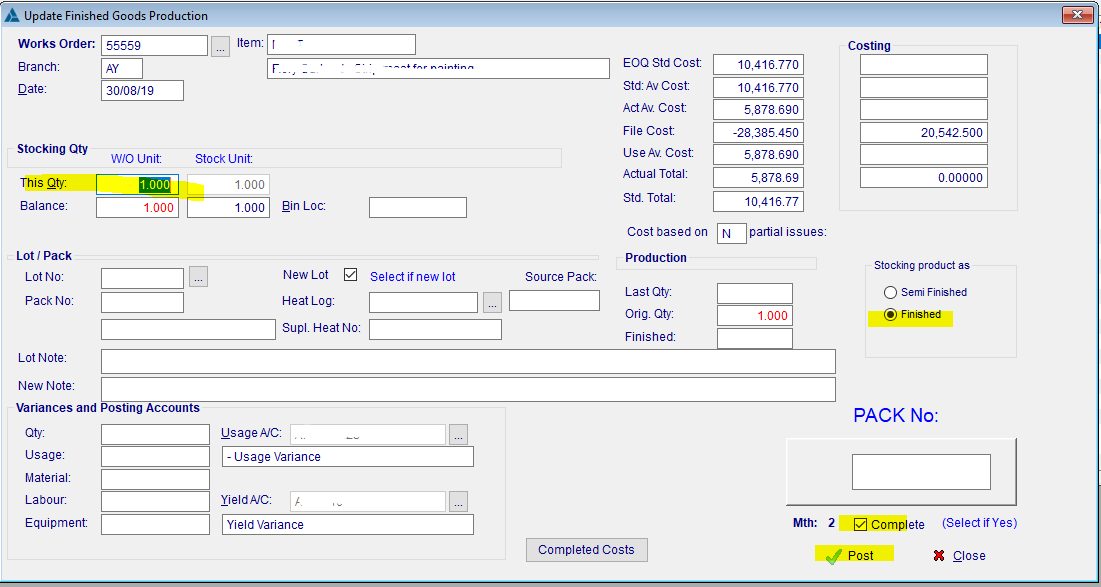
We now Stock this Item
Now look at this Item in inventory, and check the transaction.

In the GL - AC1320 - Inventory Control Acct

In the GL - AC1330 WIP Control Accoount

The Item has been transferred from WIP to Inventory at the Actual. Cost. That is Actual Material, Actual Labour and Actual Machine. The Estimates have been ignored.
No offsets have also been written as they are not required.
| Transferred from WIP | ($5878.69) |
| Transferred into WIP | |
| $2786.59 |
| $1092.10 |
| $2000.00 |
| $0 |
| $0 |
| Total transferred into WIP | $5878.69 |
| Imbalance | $0.00 |
|---|
We enter a late timesheet against the WO 55559.

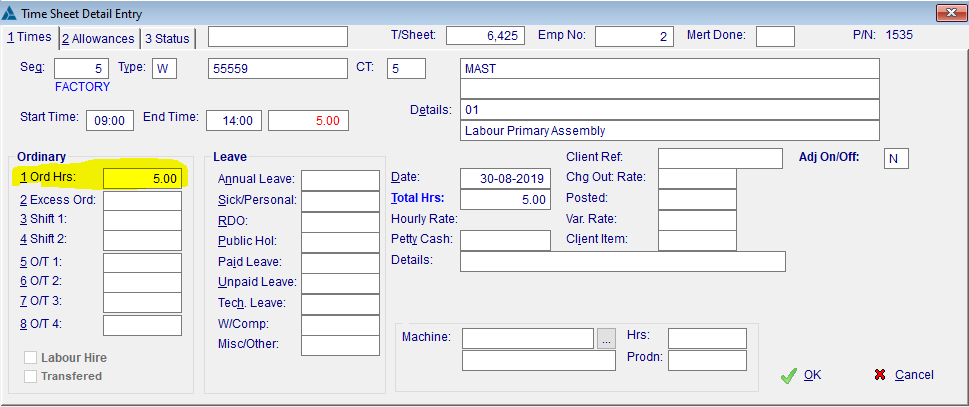
The Timesheet is Posted as normal.

The cost on the Works Order is updated to reflect the extra labour.
| Before | 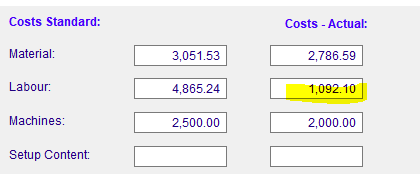 |
| After |
|
In the GL - AC1320 - Inventory Control Acct

There is NO 2nd entry, Inventory has not been affected.
In the GL - AC1330 WIP Control Account

We see the late time-sheet, Debting AC1330 (WIP) and Crediting AC1400.20 (WIP Time Sheet costing)
